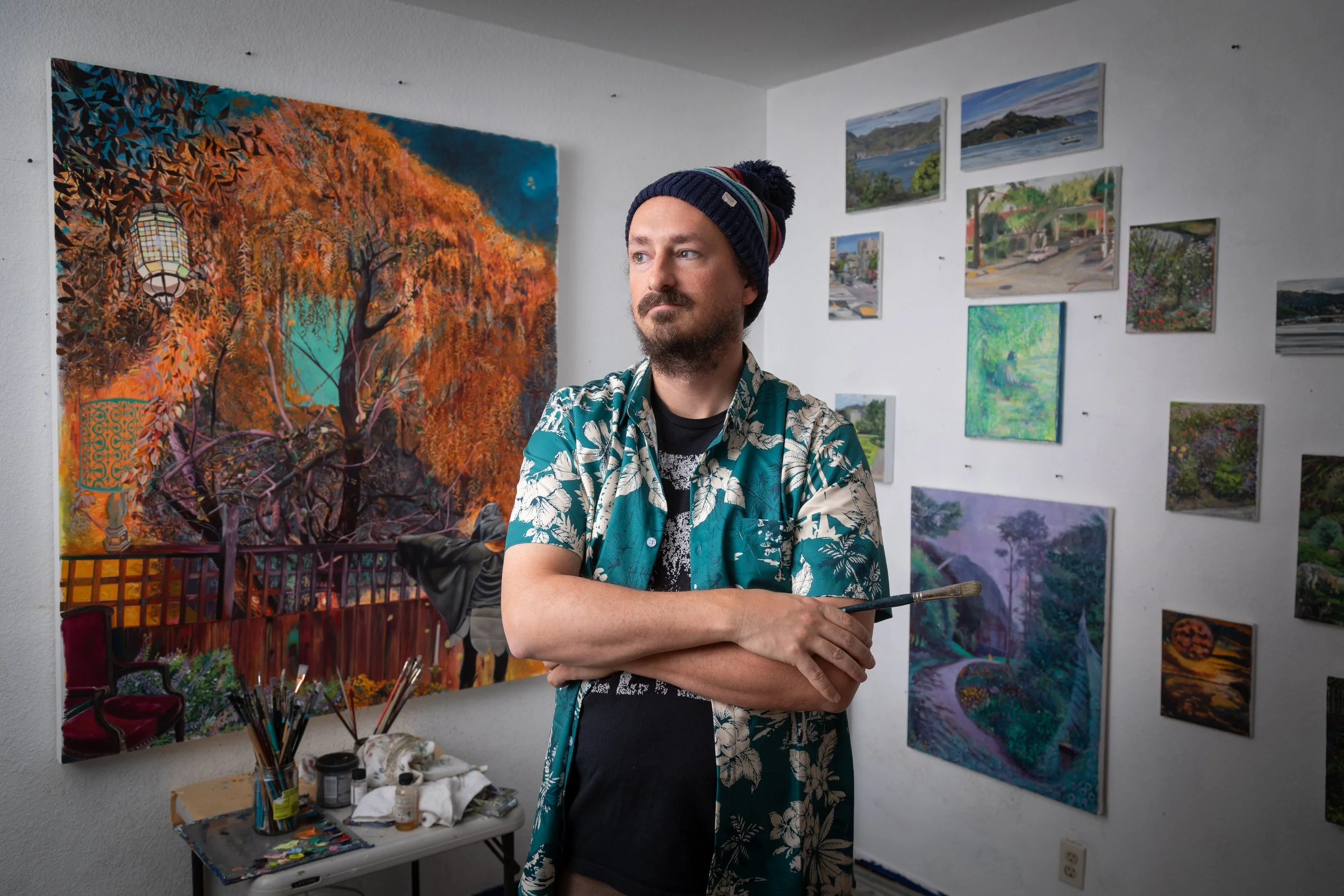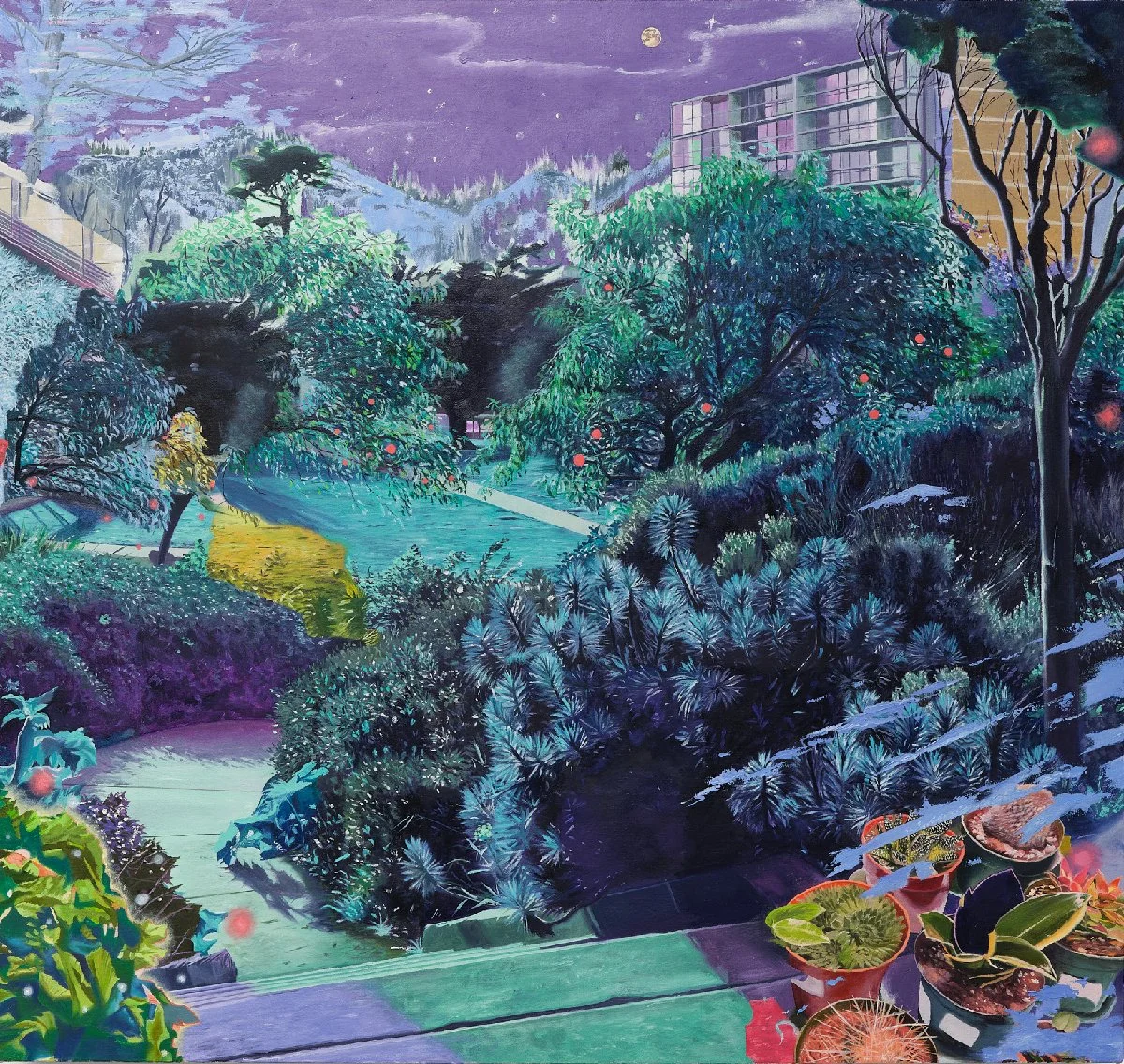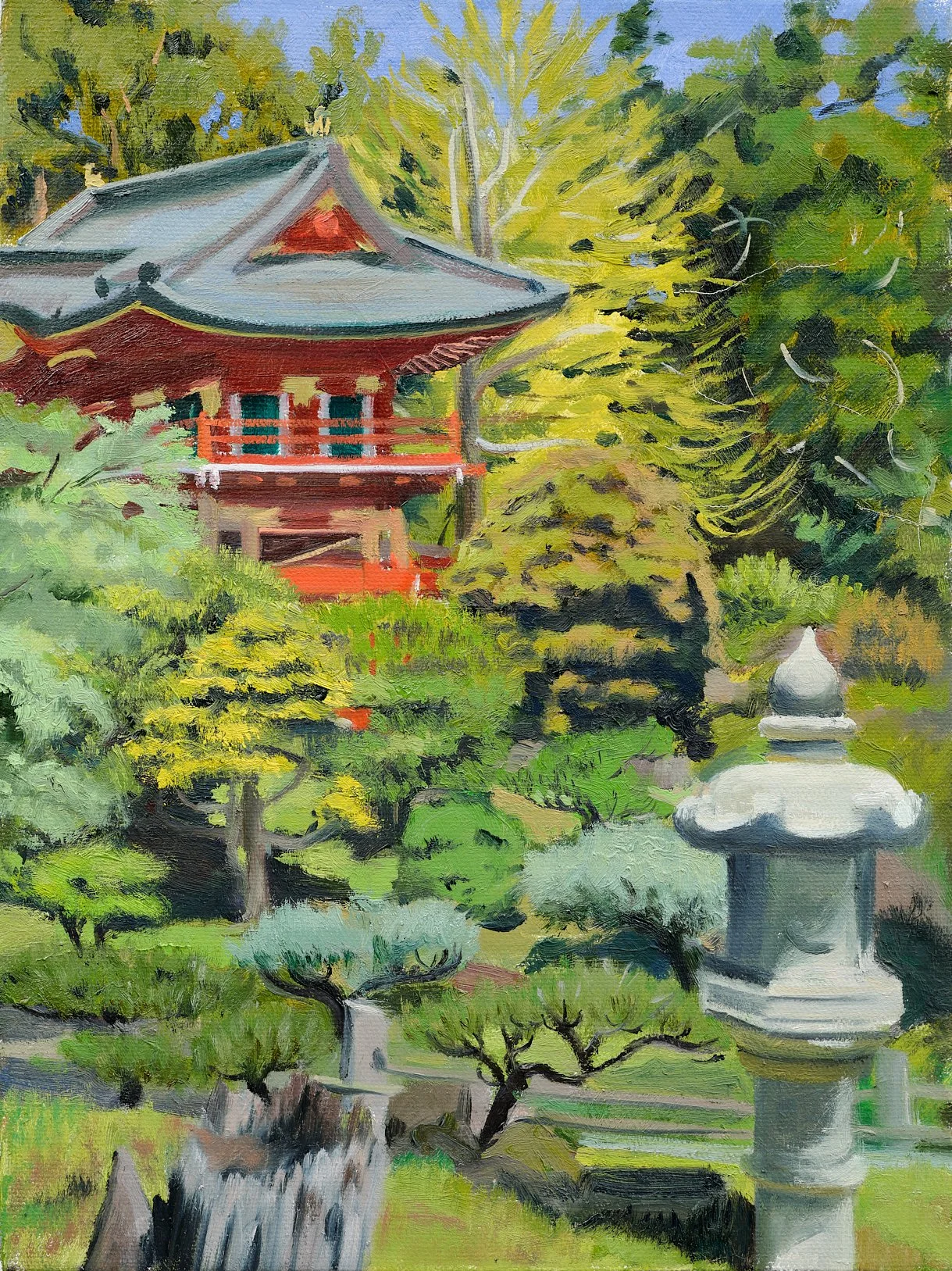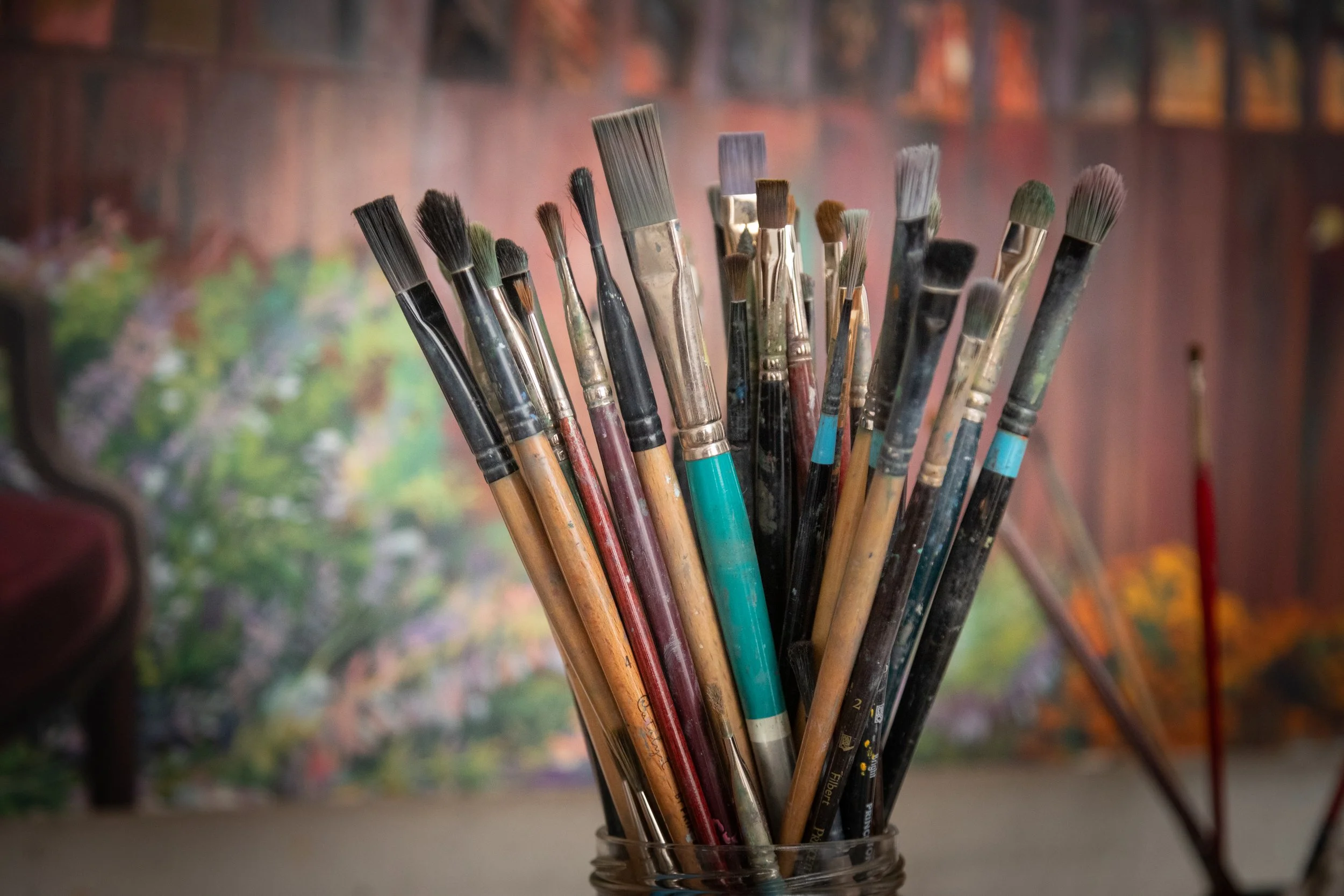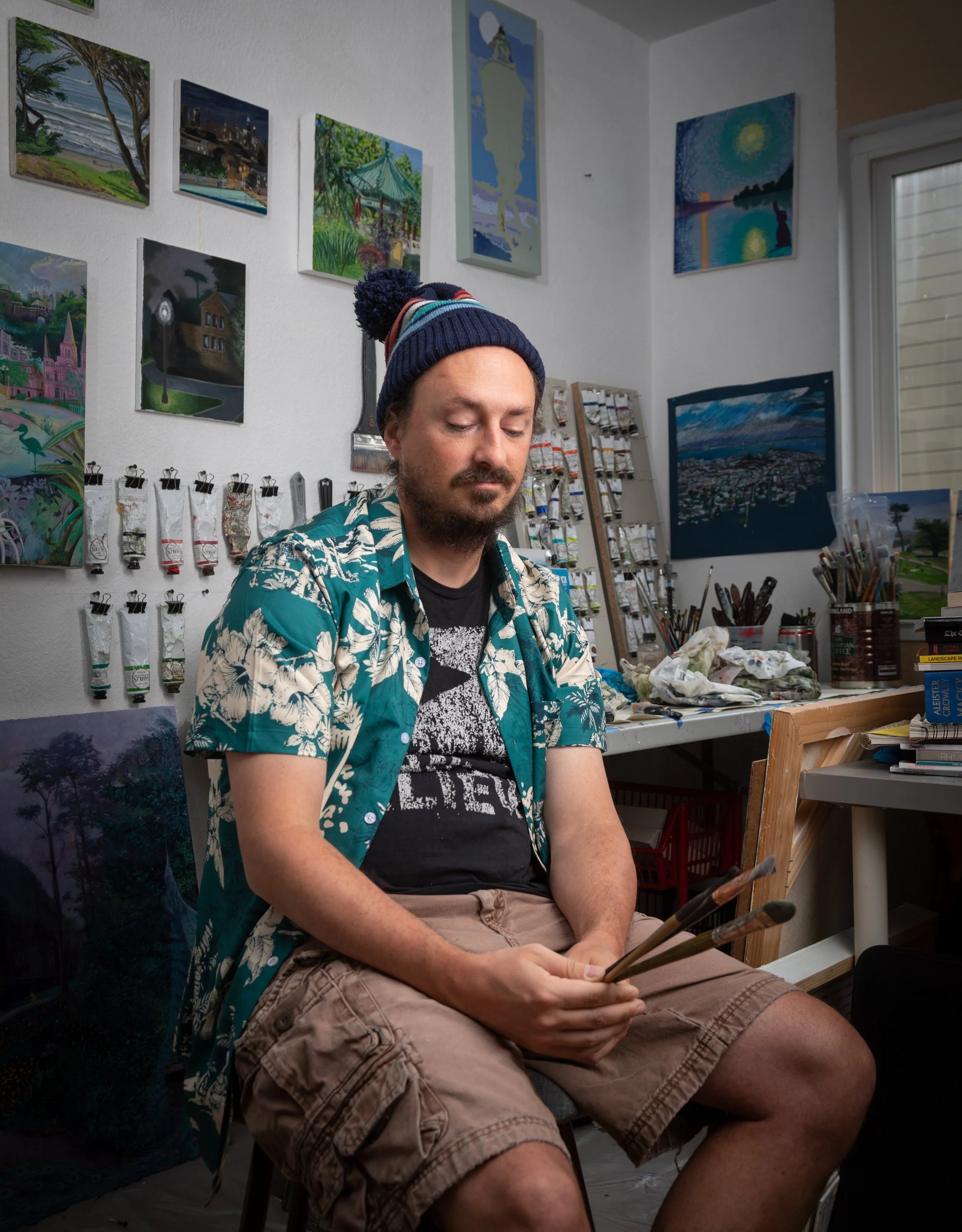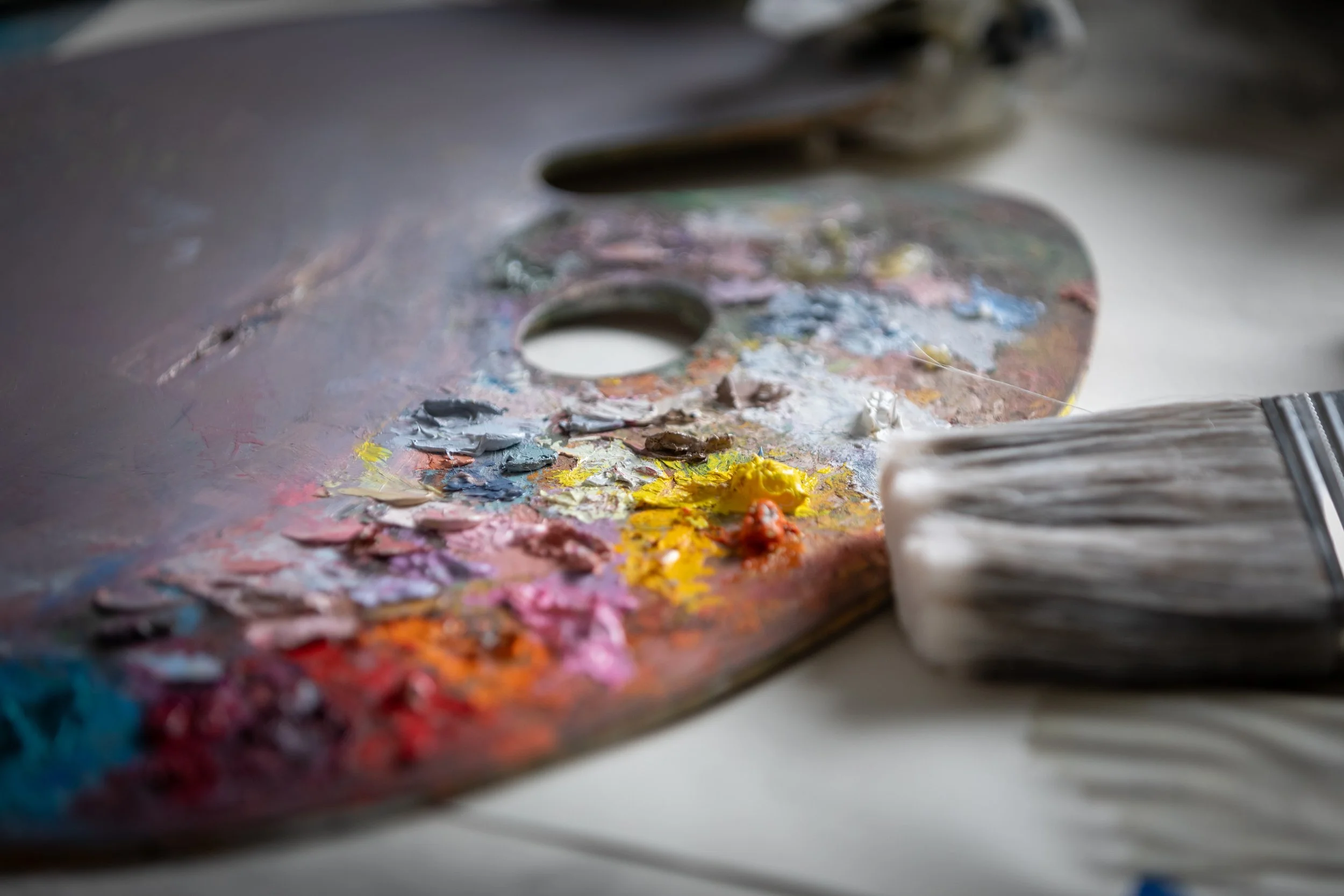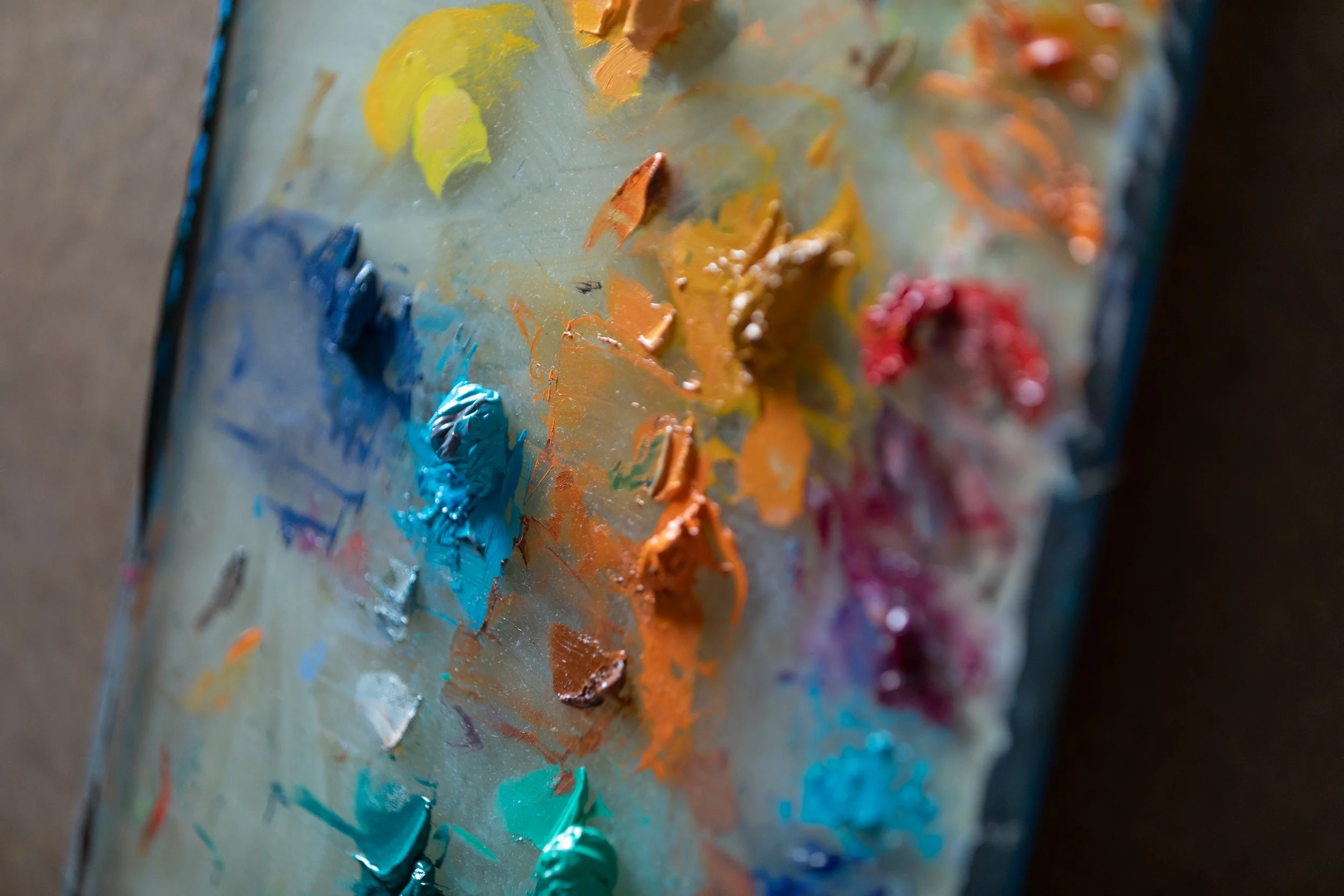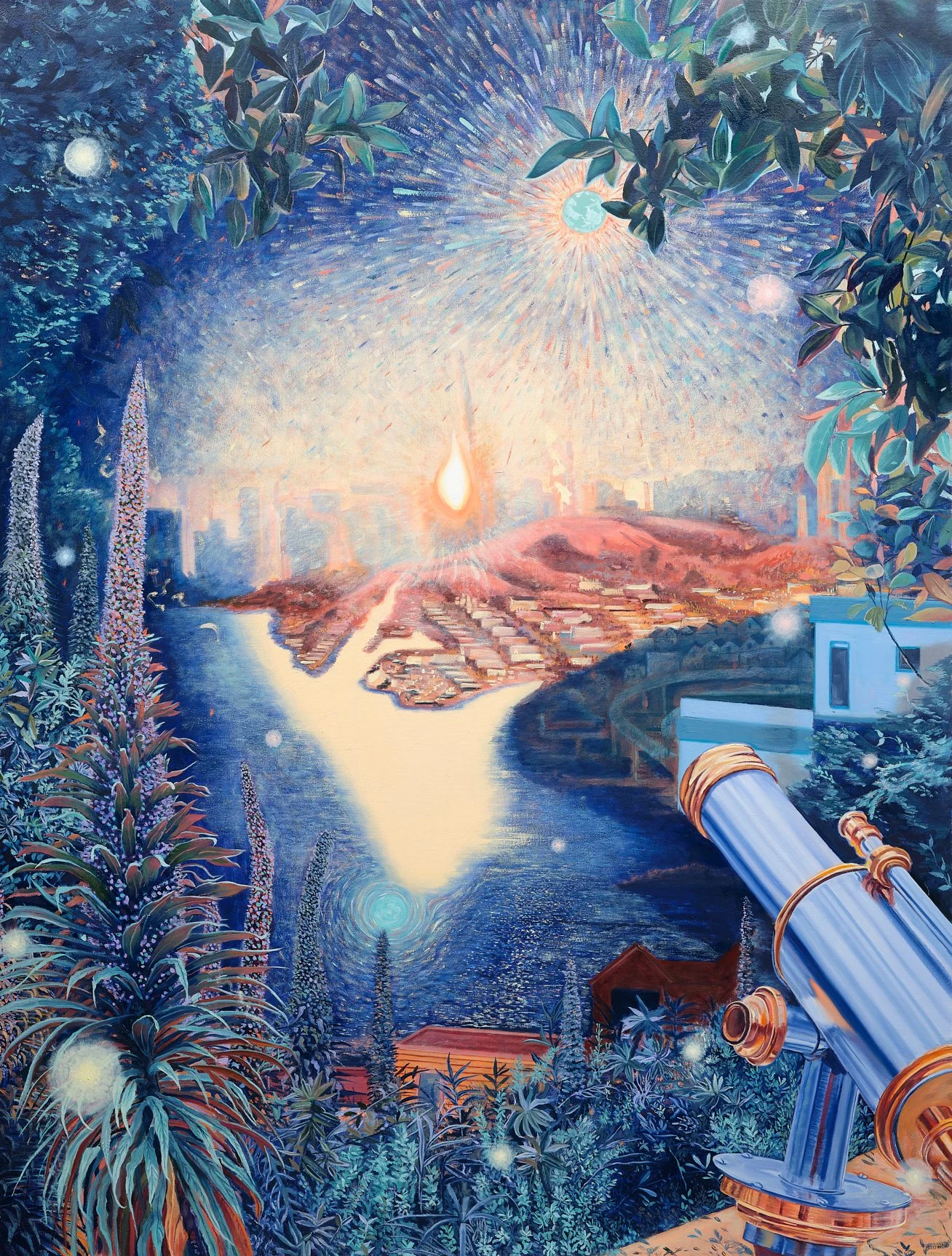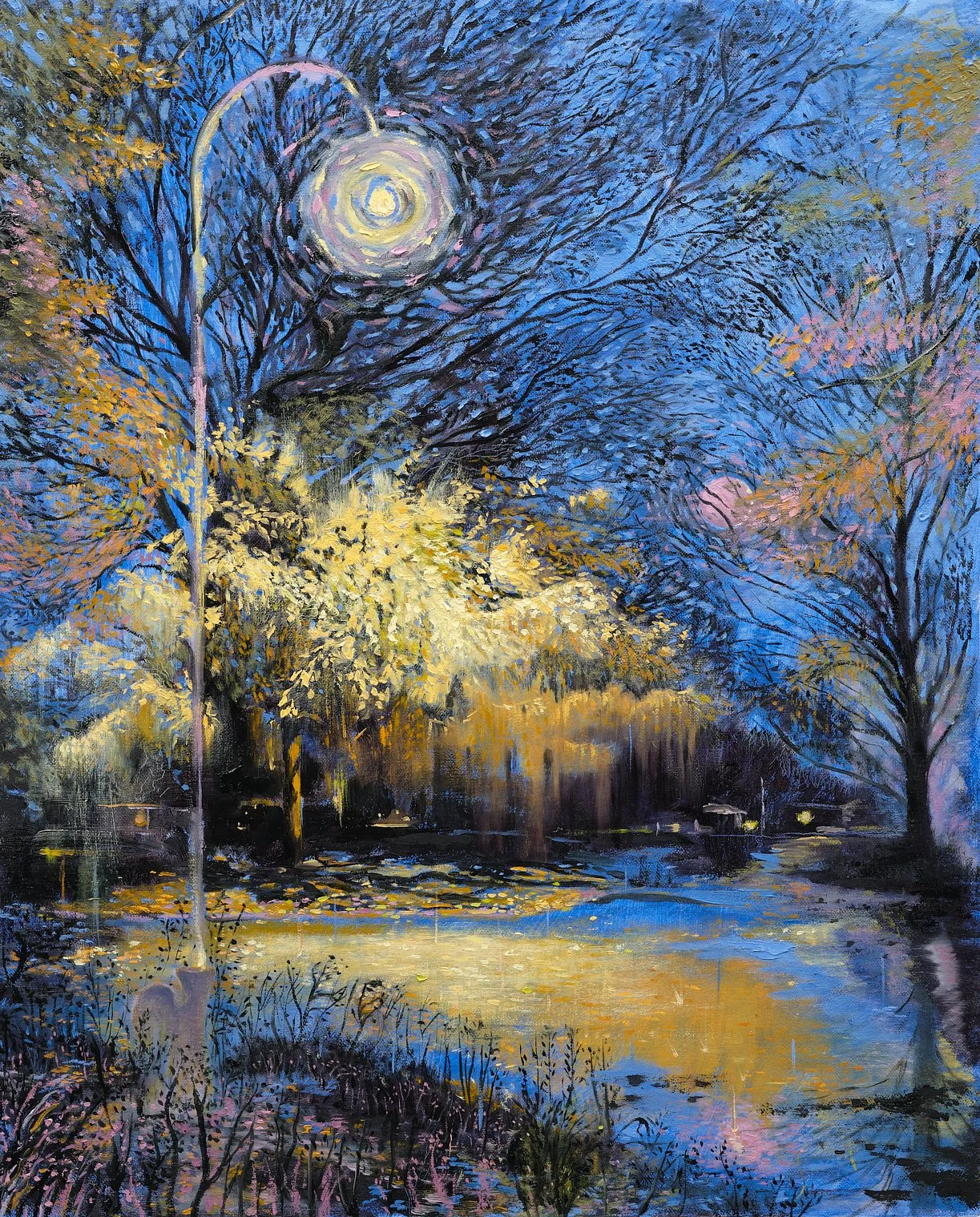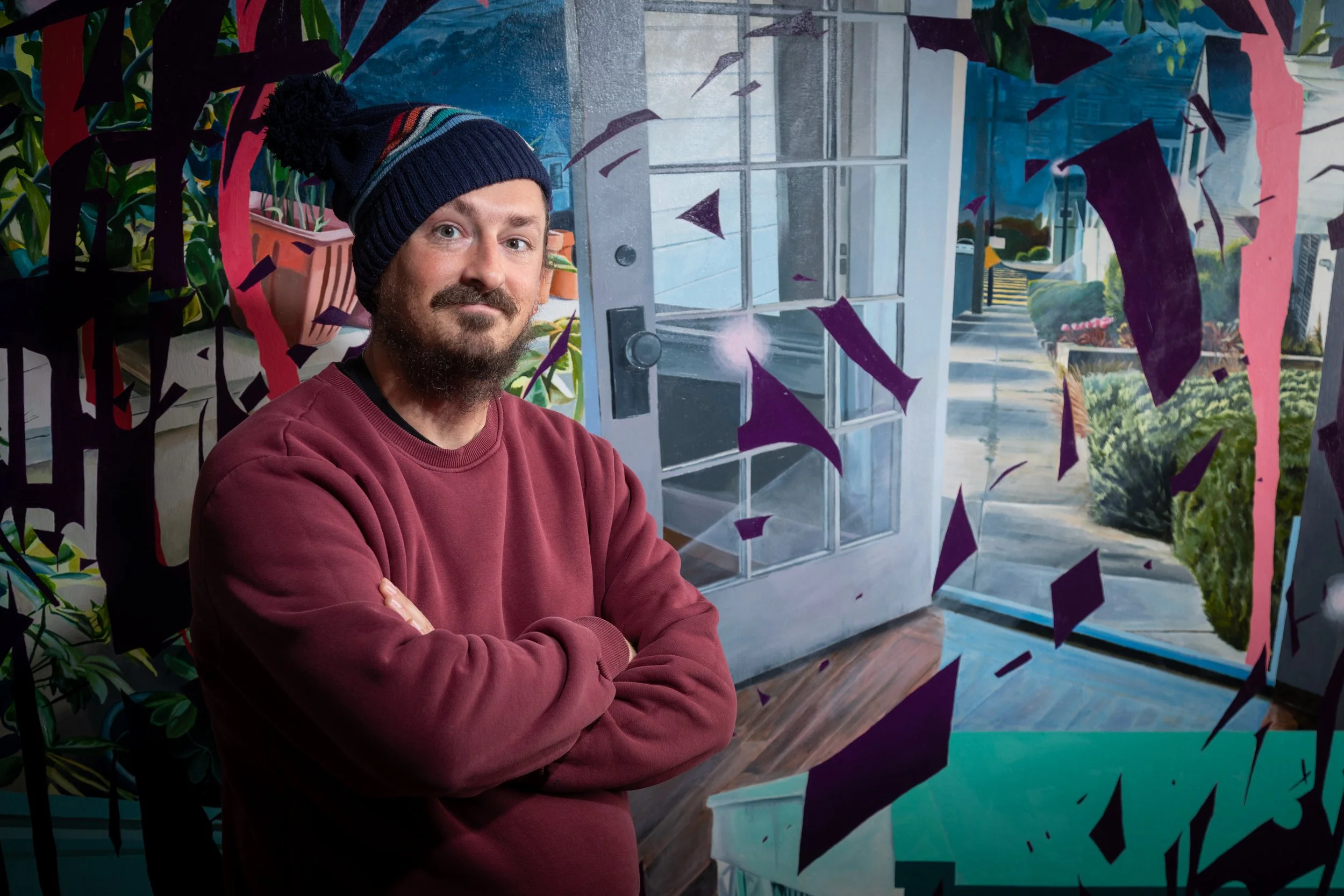Studio Visit & Interview with Tom Colcord
By John Vochatzer
With Photography By David Schmitz
Nestled in San Francisco’s Sunset District, with Golden Gate Park as both neighbor and muse, Tom Colcord’s home studio feels like a retreat into the world of his art. Inside the walls are filled with his vibrant and varied works, ranging from loose studies capturing fleeting inspirations to his large, meticulously detailed oil paintings. This diversity reflects not only the scope of Tom’s artistic prowess but also his ever-evolving approach to the creative process. Recently, he’s been embracing a more experimental period, allowing himself to explore and integrate new influences without the immediate pressure of exhibitions.
The core of Tom’s work, his “Fluidity of Perception” series, draws from a deeply layered well of personal interests, ranging from spirituality and Eastern mysticism to Western esotericism and occult studies. He brings his viewers into a world where perception is dynamic–shaped by layers of memory, personal experience, and consciousness. His recent travels to Europe, where he encountered art that moved him profoundly, and his ongoing study of artists like Matthew Wong, have encouraged him to explore a more painterly, textured approach in his pieces. Each painting becomes a space where past, present, and future converge, often inspired by his background in plein air painting—a practice he’s honed since his days studying at Indiana University Bloomington.
For Tom, painting isn’t just about putting brush to canvas– it’s a way to unpack the nuances of how we see and understand everything around us. His process is equal parts discipline and curiosity– structured but always leaving room for the unexpected. In the studio he allows himself to follow tangents, to make mistakes, and to shift directions as new ideas emerge. And in the end each piece becomes a dialogue, a conversation between him and the world he’s interpreting and one that continues to unfold in surprising ways.
Interview
Hey Tom! Thanks again for having me in your studio recently. Can you start by telling us a little bit about what you’ve been working on lately?
Hiya John! Lately I have been pecking around on a lot of little stuff and big stuff all at once. Since I don’t have any major solo shows coming up in the immediate future I’ve been taking the opportunity to experiment and relax a little with my practice. I think up until my last solo show at Glass Rice Gallery my working process was really tight and tidy, which was a great prescription for productivity, but after the show it felt constricting.
This has led to a lot of experiments in how I can continue to pursue my main body of work my “Fluidity of Perception” series. Basically I have been super inspired the last couple of years by Matthew Wong's work in particular, as well as a trip I got to take to Spain and France with my wife last summer, where we visited the Prado, The Theissen and The Musse D’ Orsay in Paris. Obviously I was totally blown away seeing so many amazing things in person. All this has culminated in me taking a more painterly approach and leaning harder into my interest in God, Spirituality, Eastern Mysticism, Western Esotericism and the Occult in general.
“California Nocturne”, Oil on Canvas, 32”x34”, 2023
Your work is rooted in a plein air painting practice that began while you were studying in Indiana University Bloomington. How did you first get into plein air painting, and how has your practice developed over time?
In the summer between my junior and sophomore years at IUB I took a Plein Air Class with Eve Mansdorf and recognized immediately how different the process was from a standard studio painting process. I have detailed this period of growth and how I see it influencing my work in a Zine I published last year that you can order from me via Instagram, but essentially I found that it’s an approach to painting that more deeply connects you to the subject matter, because you are a part of its perceptual understanding moment by moment while its being painted. Painting from life really does add a special “magic” to the painting that I now cannot unsee, even when looking at other artists' work. It’s more alive in a certain way, I feel because the artist is actually a part of the subject while the art is being conceived. A painting made in Plein Air is an artifact from a conversation you had with nature.
Your home and studio are right next to Golden Gate Park. How would you say the park influences your work? And how do you find San Francisco in general for plein air painting?
SF is ideal for plein air painting in almost every way. You can find any kind of natural scene you want to paint all within a 7x7 mile radius. And I am not just talking about the city versus nature, the ocean, etc. The people here are also so diverse and interesting and exciting to paint. Life is so alive everywhere here and as a result this place is constantly changing. San Francisco is an exceptional subject matter for all these reasons. This is something I feel is sadly underutilized, I wish there was some way I could import all the plein air painters in America and have them all live here.
“Red, Green, and Grey”, Oil on Canvas, 12”x9”, 2024
Living next to GGP is also a dream for sure. I grew up in the woods to some extent and being in nature is important for my psyche. I’d say the main thing the park does for me, other than a constant source of subject matter, is just keep me mentally balanced.
I found it interesting that often your painting process begins with digital collages, and that you spend several months sitting with them before turning them into paintings. Could you tell us more about the collage process and how it fits into your overall practice?
Yes! So my “Fluidity of Perception” series has always started out as a digital collage (polar opposite from my plein air approach I know). I take photos constantly of things and places I find visually interesting and mix them around on photoshop. I work on several of them all at once in disparate sprints. Often leaving one unfinished for over a year. They are always in flux until I find one has the refinement of becoming a painting that fits the series, in which it feels like a fluid yet logical space where past present and future can coincide. This I feel is the most accurate illustration of the Mind that I can possibly communicate in the medium of painting.
I also like to think of the photoshop collage process as sort of a post modern exercise in remixing my life experience. Like if I was a hip hop producer tasked with creating a remix of my visual experiences. I would need to cut, edit and constantly rearrange what I have seen so that the more ecstatic truth, or spiritual/mystical meaning of life experience were yielded rather than the “real one.” Which, I believe we experience as a series of mundane events broken up by little tectonic shifts of slight change.
I also really think the “sitting with it” part has become way more important to me in the past year. Like I think being in grad school really conditioned me to always be finishing paintings for critique or silly deadlines and for a long time that extended into my practice when I got into the “real world” lol. Therefore I often only worked on one thing at a time. Obviously a great discipline for productivity until it ends up driving you insane.
Since I have opened up a lot more in the past year or so, I’ve allowed myself the freedom to start random projects whenever I feel like it and finish them whenever it suits me. Obviously this has its downsides in that it easily creates disorder and clutter. But this has also allowed the paintings to evolve in more natural and less forced ways which I hope ultimately communicates a sense of activity in the painting for the viewer.
You mentioned that Buddhism and meditation are important parts of your life and art practice. Could you elaborate on how these influence your creative process?
I was having a tough time for a couple years and leaned on a lot of therapy to help me navigate my mental health. One therapist I worked with for a while also acted as a sort of meditation teacher and he reintroduced the practice in my life in a much more authentic way than it had ever been presented to me before.
I essentially began to understand how my mind is more like a limb, it’s a simulation machine there to aid in my survival. “My thoughts are not Mine” was his mantra and I began learning how to identify my words and actions as reflective of myself rather than the flurry of intrusive and upsetting thoughts I was experiencing.
Slowly I began to realize that my “Fluidity Of Perception” series was more about me wrestling with the functions of the mind than about discovering some sort of mythical world, parallel universe, or alternate reality. As a result I now understand the Mind in a more objective way and use the approach to talk about that instead. Which is liberating because I believe it reveals the truly vast range of what reality offers, there is no need to escape into fantasy when you learn how to sit with the silence and appreciate what's already here.
Anyone curious about more elaboration on this, I’d recommend watching episode 6 of the Netflix Series “The Midnight Gospel” where Duncan Trussel’s character interviews David Nichtern. Duncan’s podcast “The Duncan Trussel Family Hour” (The DTFH) has been a huge influence on me over the past half decade or so.
You’ve also explored the Occult in your studies. Could you expand on how that influences your work?
In addition to the meditation/buddhist thing Ive also gone down the Occult rabbit hole. Inevitably, you end up running into a lot of Aleister Crowley’s work, which while problematic in many ways, is fascinating and mind expanding. I am also very interested in Madame Blavatsky, I found an abridged copy of “Isis Unveiled” in a bookstore in New Orleans and felt inspired by the parts I could understand. There are many results to studies like this but the most prevalent one is the feeling of an expanded consciousness, which really just means a better understanding of the self, your emotions, intentions, and a more objective view of your life in general.
My biggest influence however is Robert Anton Wilson. He synthesizes so many ideas all together resulting in a sort of enlightened version of Agnosticism, in which he treats ALL belief systems as reality tunnels that one might go down or switch between at various points. To me it’s the most accurate version of living a truly tolerant life that I can think of because its taught me to approach everyone I meet where they are at.
“Foresight”, Oil on Canvas, 42”x32”, 2024
In my “Fluidity Of Perception” series I have begun using more specific color palates to illicit complex emotional states. The painterly approach I’ve been incorporating lately I think also adds to this. This reflects the vibe of whatever reality tunnel we may be perceiving our environment at any particular moment. In other words what we inherently believe influences the way we experience reality coloring it in a certain way that is never completely accurate but leaves a certain impression on our psyche that if we aren’t already aware of, heavily influences how we speak and act.
At the very least it's very beautiful and interesting. If you're feeling brave check out Robert Anton Wilson’s “Cosmic Trigger” series of books.
In addition to your personal practice, you teach art to youth of all ages. How do you balance the demands of teaching with your own creative output?
Hee hee, I don’t! Balance is another illusion. It’s always a struggle to find time for painting in between work and other commitments. I just try to squeeze in the time whenever I can. As a result I think I’ve just become the kind of person who doesn’t watch sports or much TV, or is able to talk at length about anything I’m not already super interested in. It’s not recommended to be an artist.
Teaching the youth does however greatly influence my painting and writing. Perhaps it’s because its an activity that is all about serving someone elses needs and not my own. It makes me more humble and therefore more open to weird ideas. Spending time with kids is great for ideas. I get all my best ideas while at work.
“Suburban Night Magic”, Oil on Canvas, 21”x17”, 2024
You also enjoy writing and are working on a book of stories. How does writing compare to painting for you as a creative outlet?
I am still trying to figure this one out. The one thing I can say for sure is that they get in the way of each other like I have two children and they are both fighting for my attention. One thing I am sure of is the mood for both is different. Stories satisfy my desire to create narrative and levity and to be sardonic. The painting I think scratches an itch that desires to see novel situations, beauty and feels more like I'm heading out on an adventure. The painting is more sensorial as well and the stories feel more like a provocation.
Lastly, what are your goals as an artist, and where do you see your work going next?
Another hard question. I want the painting to continue to provide more spiritual sustenance in my own life and continue to be a place of exploration and growth. I would also very much like it to provide more income. I recognize these could be considered paradoxical but one of the lessons I’ve learned in life is that the most valuable things in life have opposite characteristics.
I would definitely say that the more painterly versions of the Fluidity of Perception series will become a more dominant approach for me. Also keep a look out for a collection of short stories I plan on publishing towards the end of the year!
Also currently I have an exhibition up at GCS Agency also featuring the work of Ryan Martin and Kuntal! Go check it out!
